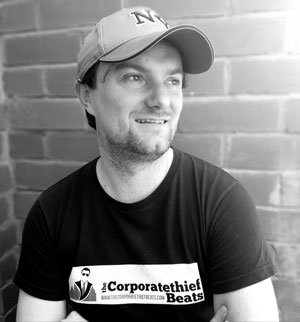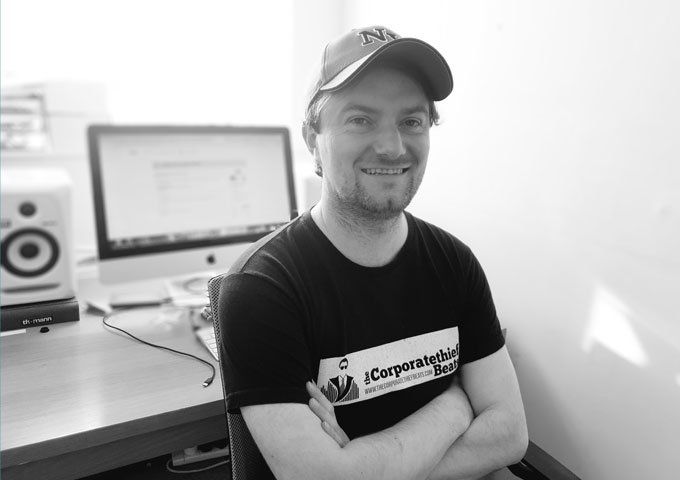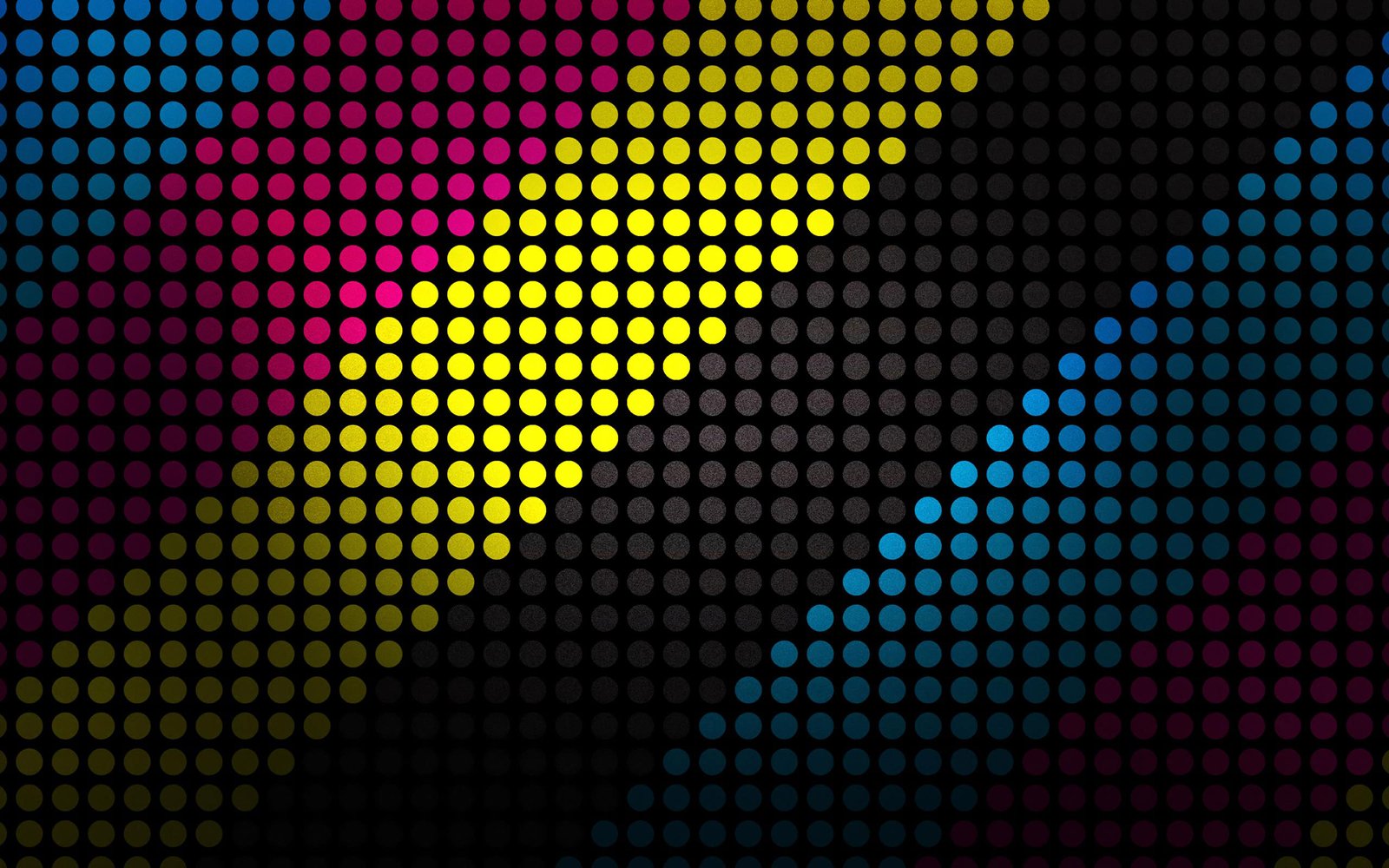Hip-hop’s digital frontier demands more than just raw talent; it requires savvy navigation of the online world. One name synonymous with empowering artists in this realm is The Corporatethief Beats. Daniel Hartnett, the creative force behind this project, has built a brand that’s more than just a collection of beats; it’s a resource, a community, and a Launchpad for aspiring rap artists and beatmakers. Since 2010, The Corporatethief Beats website has grown exponentially, offering everything from high-quality hip-hop instrumentals to invaluable guidance on online music marketing. In an extensive interview we delve into the world of Daniel Hartnett, exploring his creative process, the inspiration behind The Corporatethief Beats, and the keys to success in the modern music industry.

1. What was the moment that made you realize hip-hop production was the path you wanted to follow?
That’s a funny answer. I didn’t grow up listening to hip-hop. Looking back, I think The Marshall Mathers LP by Eminem was the only hip-hop album I owned when I was 11 or 12. Before that, I mainly listened to Michael Jackson, Prince, and The Beatles.
When I turned 14, I started playing guitar and got into grunge music—bands like Alice in Chains, Nirvana, and Soundgarden—right up until I went to college. But when I got to college, my friend Mikey lent me his laptop, which had FL Studio (called Fruity Loops at the time) installed. He was making hip-hop beats on it, and around the same time, I discovered a new rapper named Kid Cudi. Keep in mind, this was 2007/2008, and Cudi hadn’t blown up yet.
Mikey also introduced me to more hip-hop music, including Kanye West, who became a huge influence on me. While Mikey saw music production as just a hobby, I became obsessed. Since I already had some musicianship from playing guitar, making beats came naturally—I had an ear for music. Eventually, I transitioned to Logic Pro and pursued formal education in music production and sound engineering at Galway Technical Institute and The Academy of Sound Dublin.
2. How did your early experiences as an acoustic musician shape your approach to making beats?
Massively. I was lucky that my parents encouraged me to participate in a lot of extracurricular activities at school, such as learning the accordion and piano. I kind of discovered the guitar on my own because I had some friendly competition with my friends.
My friend Mike from college gave me his laptop with Fruity Loops on it because he saw me trying to record my own acoustic songs using Audacity. Audacity wasn’t bad at the time, but FL Studio was ten times better. Playing the guitar helped me develop an ear for music, and without that, I don’t think I would know what I’m doing today.
3. Kid Cudi was a big influence on you—what specific elements of his style resonated with you the most?
I wouldn’t be The Corporatethief Beats if it weren’t for Kid Cudi. He was the reason I started talking to my friend Mikey, who introduced me to FL Studio. We bonded over A Kid Named Cudi—that mixtape played a big role in our friendship.
I’ve followed Cudi’s career from 2007/ 2008 to now. There’s a great interview with Travis Scott where he says Cudi is a part of his story—I feel the same way.
Travis Scott interview about Kid Cudi
Cudi’s lyrics spoke to a generation of young men between 16 and 25. I still remember every word of Soundtrack 2 My Life—those lines had soul:
And I tried to piece the puzzle of the universe
Split an eighth of ‘shrooms just so I could see the universe
I tried to think about myself as a sacrifice
Just to show the kids they ain’t the only ones who up at night
The moon will illuminate my room and soon I’m consumed by my doom
Cudi’s lyrics were never meant to be compared to rappers like Jay-Z or Nas. He carved out his own lane in hip-hop—his music wasn’t for fans of Jay-Z, 2Pac, Biggie, or Nas. Instead, his lyrics resonated with young men working crappy, dead-end jobs, trying to figure life out.
The lonely loner seems to free his mind at night
He’s all alone through the day and night
The lonely loner seems to free his mind at night, at, at, at night.
Day and night
4. Aside from hip-hop, are there any unexpected musical influences that inspire your sound today?
Yeah, I’ve always been a fan of Trent Reznor from Nine Inch Nails. In particular, The Downward Spiral (1994) and With Teeth (2005) are two of my favorite albums. I also have a massive appreciation for pop music producers like Danja (Danjahandz), Max Martin, ILYA, Bloodshy & Avant, Benny Blanco, and Frank Dukes.
If you really listen to my music, you can hear Danja’s influence—especially in his approach to pop song structure. He produced Britney Spears’ Blackout album, and the music production elements he used in that project are still ingrained in my music production to this day.
The Weeknd’s first three mixtapes—House of Balloons, Thursday, and Echoes of Silence (2011), also known today as Trilogy—had a huge influence on my music. You can hear that influence in one of my latest beats, Don’t Kill The Weeknd.
https://www.youtube.com/watch?v=wnipWsEswjg
5. Can you walk us through your typical workflow when creating a new beat from scratch?
I always try to have an artist in mind when making music. I start by searching for sounds and experimenting until something catches my attention.
“I need to find what I call The Click or The Hook quickly”
—otherwise, I lose interest too fast to continue.
Once I find The Click or The Hook, I start sculpting the beat, shaping it to take the track in the direction I envision.
The structure of a track depends on the style. For example, trap beats tend to be minimalistic, with fewer elements over time. However, I like to break those rules by incorporating pop elements I’ve learned from studying Danja’s production techniques.
6. You mentioned using Logic Pro for 99% of your beats—what features make it your go-to DAW over FL Studio or Pro Tools?
The main reason I use Logic Pro is that the first college I attended, Galway Technical Institute, taught it. During that year, I worked a bar job, saved up, and eventually bought my iMac, Logic Pro, a MIDI keyboard, and an Mbox audio interface. Now, I use the Duet.
I also studied music production and sound engineering at the Academy of Sound in Dublin, where I learned to use Pro Tools.
However, I still prefer Logic Pro because I can get my ideas out much faster.
I know my way around Logic Pro like the back of my hand.
While I can use both Pro Tools and FL Studio, my efficiency isn’t at the same level as it is with Logic Pro.
I use a lot of in-the-box synths built into Logic, like the ES1 and ES2. I also have hundreds of my own and other people’s samples and sounds stored in my library. Additionally, I use Sylenth1, and a long time ago, my brother gave me the Komplete 8 pack.
One of the biggest advantages of Logic Pro is its built-in mixing tools. The stock EQs, compressors, amps, and reverbs are exceptional, making it a powerful DAW straight out of the box.
7. How do you balance live instrumentation with digital elements in your beats?
I won’t add live instrumentation to a beat unless I feel it truly needs it. For example, the guitar solos in The Weeknd-type beats I’ve made blend hip-hop and rock, so the rock guitar naturally fits into the mix.
Sometimes, I’ll add a guitar riff but manipulate it so much that you wouldn’t even recognize the original sound.
8. What are some of your favorite VSTs or plugins that you rely on to create your signature sound?
Sylenth1 and Komplete 8 are the main VSTs I use, along with Logic’s built-in ES1 and ES2 synths. When I was starting out, I couldn’t afford to buy new VSTs all the time, so I focused on learning how to create sounds using samplers or by manipulating presets from other producers.
9. How important is sound design in your production, and do you ever create your own samples?
Sound design is a crucial part of my production process. While I do use samples, I always make an effort to tweak and manipulate them to create something unique. If I find a sample I like, I’ll often try to recreate a similar vibe from scratch to avoid copyright issues. This ensures that my beats remain original while still capturing the sound I’m going for.
10. Beat leasing can be confusing for many artists—what was your main goal in simplifying the process through your beat packs?
I noticed that music producers on sites like TryBuyBeats.com, Airbit, and BeatStars were offering 4–6 different types of lease agreements. However, most artists have no idea what these agreements actually mean. Many of them are still in the hobby phase of making music and don’t want anything too complicated.
That’s why all the beat packs on The Corporatethief Beats website come with a single unlimited lease agreement, including the track stem files, making it simple and hassle-free for artists.
11. What strategies have you found most effective in promoting your beats and reaching independent artists?
Email marketing is one of my core strategies for maintaining open communication with artists who purchase rap beats from my website. I use different email sequences—some focused on sharing music marketing tips and others designed to drive sales.
In addition to email, I run basic remarketing campaigns on Google Ads, Meta, and Bing to stay engaged with potential customers and bring them back to my site.
12. The online beat marketplace is highly competitive—how do you ensure your brand stands out from other producers?
I believe my ability to create strong song structures is at the core of my music production. As I mentioned earlier, my influences from Danja, particularly his approach to structuring pop music, have shaped the way I create Sample Beats, Beats with Hooks, Trap Beats, and Pop Beats.
Even my darker, more intense trap beats have melodic pop influences woven into them.
Additionally, I think The Corporatethief Beats is such a unique name that I’m confident there aren’t any other beat makers with a similar brand or identity.
13. Have you noticed any major shifts in how artists are buying and using beats in recent years?
The majority of artists who purchase beats from me tend to focus on buying beat packs from the beat player. The beat packs just make sense—they offer way more value. To enhance that value, I also include micro-courses, eBooks, and cheat sheets in the backend.
Over the years, I’ve seen different waves of beat trends. There was a period of trap beat dominance, then a shift towards beats with hooks, and later, a demand for more emotional, sample-based beats—similar to the early type beats inspired by Drake’s first albums or the Trap Soul sound that blew up when Bryson Tiller emerged.
14. What was the biggest challenge in writing The Rap Lyricist’s Handbook?
The Rap Lyricist’s Handbook isn’t meant to be read in a single day. It’s designed to be a resource you can reference time and time again—whether you’re dealing with writer’s block, improving your rap lyrics, looking for sites that teach you how to rap, or searching for tips on music recording, marketing, and promotion.
As the tagline suggests:
“The Rap Lyricist’s Handbook” is not just another book to skim through. It’s a powerful resource designed to be your go-to companion on your journey to rap mastery.
The biggest challenge was making it engaging—nobody wants to read a wall of text. That’s why I included vibrant, colorful images to keep it visually appealing and to serve as reference points for key topics.
The eBook is also interactive, with jump links throughout to make navigation easier. Plus, it features QR codes that link to curated videos and the same marketing tools I personally use to promote my music.
15. How do you see the handbook helping aspiring rappers beyond just improving their lyrics?
Let’s be real—an eBook won’t teach you how to rap in a day.
Rapping is a skill that requires daily practice. There’s no shortcut around that.
What The Rap Lyricist’s Handbook is designed for is those moments when self-doubt creeps in—when you need a spark of inspiration or guidance on how to promote your music effectively. It’s not just a book; it’s a resource to keep you motivated and on track.
16. Your blog offers extensive resources for independent artists—what are the biggest mistakes you see them making in marketing their music?
Artists have no plan. They sit around waiting for the world to hand them something or for someone else to “put them on.”
They make excuses. They keep saying, “Nobody will give me a chance.”
The truth is, you have to build and cultivate your own audience. Don’t wait for shady middlemen who promise they can “put you on” or offer “exposure” and “promo.” These so-called industry insiders are often just sharks—they can barely promote themselves, relying on spammy DMs and cold emails.
Instead, you need to take control of your own success. Learn how to use advertising tools like YouTube Ads, Google Ads, X.com Ads, and Meta Ads to drive a new audience to your music. More importantly, you need a narrative and a story—something real that gives people a reason to follow and support you.
17. What’s one underrated tip from your marketing courses that you think all independent artists should know?
Don’t build your entire business on rented ground.
Platforms like Facebook, X, Instagram, Spotify, YouTube, ReverbNation, My Mixtapez, SoundCloud, and even Patreon don’t belong to you—you could lose access to them in an instant.
Always focus on building assets you own:
✅ Your own website
✅ Email list
✅ SMS list
✅ Membership platform
These are platforms you control 100%.
That’s not to say you shouldn’t use social media and streaming sites for marketing—you absolutely should. But always redirect fans to your website and newsletter so you’re not at the mercy of ever-changing algorithms.
I learned this the hard way. When I started out, Myspace was everything. I spent countless hours designing my Myspace page—now it’s completely irrelevant. The same thing happened with beat sites like SoundClick, which dominated from 2005 to 2014, but isn’t popular anymore.
Even DatPiff, once the go-to mixtape site for years, is completely gone today. If you build your business solely on platforms you don’t own, you risk losing everything overnight.
18. You’ve worked with a range of artists—what’s one collaboration that stood out to you the most, and why?
I really admire the work Sam Manon did with pop beats. It reminded me of when rapper Kid Berg dropped some amazing bars over one of my oldest beats. It’s crazy to think I made that beat back in 2010!
19. If you could work with any artist in the world, living or dead, who would it be and why?
Kid Cudi, Kanye, Drake, Rick Ross, Max Martin, and Travis Scott—I couldn’t choose just one. I honestly love all of their music in different ways!
20. What’s next for The Corporatethief Beats—any upcoming projects or new directions you’re exploring?
I keep creating new hip-hop beats and rap beat packs because they add a lot of value for hip-hop artists. I’ll also continue working on my other websites that provide music production and songwriting tips for up-and-coming artists.
(Article Source – https://jamsphere.com/twentyquestions/the-corporatethief-beats-empowering-the-next-generation-of-hip-hop-artists. )
Follow The Corporatethief Beats on:
Website: https://thecorporatethiefbeats.com/
YouTube: https://www.youtube.com/user/corporatethief?sub_confirmation=1
X.com: https://x.com/corporatethief


